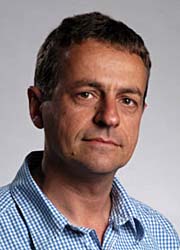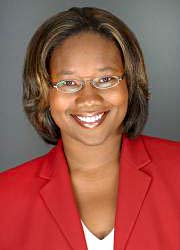Register
Click here to register on-line, and pay by credit card (deadline 5 pm, April 12th).
Click here to register by mail, and pay by check (deadline April 12th).
Spring 2011 SoCal-Nev Section Meeting
Point Loma Nazarene University, San Diego
Saturday, April 16, 2011
(Directions and Map)
Tentative Program
- 8:15-12:00 Registration
Crill Patio, Cooper Music Center - 8:15-10:30 Refreshments
Cooper Music Center Parlor - 8:30-2:30 MAA Book Sale
Cooper Music Center Parlor
Organized by Richard Katz and Michael Hoffman, CSU, Los Angeles - 9:00-10:00 Invited Address by Michael Krebs, CSU, Los Angeles
How to Build Fast, Reliable Communications Networks:
A Brief Introduction to Expanders and Ramanujan Graphs
Crill Auditorium in Cooper Music Center - 10:00-10:15 Section Business Meeting
Crill Auditorium in Cooper Music Center
Presentation of Section Distinguished Teaching Award
Recognition of 25- and 50-year members - 10:20-11:20 Student Poster Session
View the Call for posters and apply on-line.
Crill Patio, Cooper Music Center
Organized by Cynthia Wyels, CSU Channel Islands - 11:20-12:20 Invited Address by Bernd Sturmfels, UC Berkeley
Convex Algebraic Geometry
Crill Auditorium in Cooper Music Center - 12:20-1:35 Luncheon
Golden Gymnasium - 1:35-2:35 Invited Address by Talithia Williams, Harvey Mudd College
Lies, Damn Lies, and Statistics:
The Misapplication of Statistics in American Life
Crill Auditorium in Cooper Music Center - 2:35-3:00 Refreshments
Cooper Music Center Parlor - 3:00-4:00 Section NExT session (open to all)
Career Panel
Cunningham Dining Room
Directions and Maps
For directions, see the campus website. For a campus map, click on the campus map link at http://www.pointloma.edu/discover/visit.
Parking: Follow the signs to the best available lots or ask the guard at the welcome center for directions.
For hotel information, go to http://plnupartnership.com/.Register
Click here to register on-line, and pay by credit card (deadline 5 pm, April 12th).
Click here to register by mail, and pay by check (deadline April 12th).
Registration Fees
| Registration | |
| Nonmember | $40 |
| MAA Member | $35 |
| Student | $15 |
| Registration and Luncheon | |
| Nonmember | $55 |
| MAA Member | $50 |
| Student | $25 |
On-site registration will be available for the meeting, but will be $5 more than the pre-registration charge.
Register on-line
Click here to register on-line, and pay by credit card (deadline 5 pm, April 12th).
Register by mail
Click here to register by mail, and pay by check (deadline April 12th).
Bernd SturmfelsUC Berkeley |
Bernd Sturmfels received doctoral degrees in Mathematics in 1987 from the University of Washington, Seattle, and the Technical University Darmstadt, Germany. After teaching at Cornell University, he joined the UC Berkeley faculty in 1995, where he is Professor of Mathematics, Statistics and Computer Science. His honors include NSF, Sloan, and Packard fellowships; a Clay Institute scholarship; the von Humboldt Senior Research Prize; MAA Polya and SIAM von Neumann lectureships; and MAA Ford and Allendoerfer awards for expository writing. He recently served as Vice President of AMS. A leading experimentalist among mathematicians, Sturmfels has authored or edited 15 books and 190 research articles, in the areas of combinatorics, algebraic geometry, polyhedral geometry, symbolic computation, and their applications. His current research focuses on algebraic methods in optimization, statistics, and computational biology. See some of his recent papers at http://math.berkeley.edu/~bernd/. |
Convex Algebraic Geometry
Convex algebraic geometry is an emerging field at the interface of convex optimization and algebraic geometry. A primary focus lies on the mathematical underpinnings of semidefinite programming. This lecture offers an introduction with many pictures. Starting with questions concerning multifocal ellipses in the plane we move on to discuss spectrahedra and convex hulls of space curve.
Michael KrebsCSU Los Angeles |
Michael Krebs is an Associate Professor of Mathematics at California State University, Los Angeles. He received his Ph.D. in mathematics from Johns Hopkins University, and his undergraduate degree from Pomona College. His current research focuses on algebraic graph theory, specifically the theory of expander families. His book "Expander Families and Cayley Graphs: A Beginner's Guide," co-authored with Anthony Shaheen, is due to come out in Fall 2011 with Oxford University Press. For some of Mike's recent papers, as well as the opportunity to procrastinate while being mildly entertained by various mathematical videos, puzzles, and musical pieces, visit Mike's website at http://www.calstatela.edu/faculty/mkrebs. |
How to Build Fast, Reliable Communications Networks:
A Brief Introduction to Expanders and Ramanujan Graphs
Think of a graph as a communications network. Putting in edges (e.g., fiber optic cables, telephone lines) is expensive, so we wish to limit the number of edges in the graph. At the same time, we would like the communications network to be as fast and reliable as possible. We will see that the quality of the network is closely related to the eigenvalues of the graph's adjacency matrix. Essentially, the smaller the eigenvalues are, the better the communications network is. It turns out that there is a bound, due to Alon, Serre, and others, on how small the eigenvalues can be. This gives us a rough sense of what it means for graphs to represent "optimal" communications networks; we call these Ramanujan graphs. Families of k-regular Ramanujan graphs have been constructed in this manner by Lubotzky, Sarnak, and others whenever k-1 equals a power of a prime number. No one knows whether families of k-regular Ramanujan graphs exist for all k.
Talithia WilliamsHarvey Mudd College |
Dr. Talithia Williams is an Assistant Professor of Mathematics and Statistics at Harvey Mudd College. She joined the Harvey Mudd College faculty in 2008 after receiving her B.S. in Mathematics from Spelman College, her M.A. in Mathematics from Howard University, and her Ph.D. in Statistics from Rice University. As a junior faculty member, Dr. Williams exemplifies the role of teacher and scholar through outstanding research, with a passion for integrating and motivating the educational process with real world statistical applications. Her research focuses on developing dynamic statistical models that emphasize the spatial and temporal structure of data with environmental applications. Her professional experiences include research appointments at the Jet Propulsion Laboratory (JPL), the National Security Agency (NSA), and NASA. In addition to her academic accomplishments, Dr. Williams is active in various Christian ministries involving marriage and family planning. She is a member of Pomona First Baptist Church and resides in Pomona, California, with her husband, Donald, and their sons, Josiah (3 yrs) and Noah (11 months). |
Lies, Damned Lies, and Statistics: The Misapplication of Statistics in American Life
H.G. Wells once said "Statistical thinking will one day be as necessary for efficient citizenship as the ability to read and write." The widespread use of statistics plays an influential role in persuading public opinion. As such, statistical literacy is necessary for members of society to critically evaluate the bombardment of charts, polls, graphs, and data that are presented on a daily basis. However, what often passes for "statistical" calculations and discoveries need to be taken with a grain of salt. This talk will examine the applications of statistics in American media and give examples of where statistics has been grossly misused.
Student Poster Session
Both undergraduate and graduate students are invited to present a poster at the Spring Section Meeting of the MAA.
Here are some ideas of what students can present:
- Results of masters thesis, honors, senior, or independent study projects
- Results of classroom projects or modeling contests
- Results of REUs or other summer research programs
- Historical investigations in pure or applied mathematics
- Solutions of problems from the Putnam Exam or from the Monthly or other journals
Section NExT presents
a Panel Discussion on Careers in Mathematics
Moderated by Magnhild Lien, CSUN
Cunningham Dining Room, 3:00 pm – 4:00 pm
Panelists will talk about careers ranging from high school teaching to working for the National Security Agency (NSA). In addition to giving brief descriptions of their jobs, the panelists will a) talk about what math background (degree) is needed for their particular careers and b) give faculty a few pointers on advice they can give to students who are interested in those particular careers.
At the conclusion of the panel there will be a raffle for copies of the books: 101 Careers in Mathematics and She Does Math! Real-Life Problems from Women on the Job. All attendees at the panel are eligible to enter the raffle.
Panelists
Deb Cotton:
Deb Cotten is a mathematician who has worked for the National Security Agency for 14 years.
She holds Ph.D. and master's degrees from Vanderbilt University, and a bachelor's degree from Colorado College. After graduating from Vanderbilt, Deb spent one year teaching at King's College in Pennsylvania before joining NSA. After spending most of her career so far at NSA's main campus in Fort Meade, Maryland, she recently moved to San Diego for a three-year assignment.
Sheri Lehavi:
After majoring in Economics at UC Berkeley, Sheri decided to go into teaching. She got her single subject credential in mathematics from CSUN in 1995. She then taught high school math in the Manhattan Beach school district, the Beverly Hills school district and in Israel. In 2002 Sheri earned her Master's in mathematics from CSUN. She then started teaching at Pierce College part time until getting a full time position in 2007.
Krista Reader
Krista Reader graduated from California State University Northridge in 2004 with a BA in Mathematics. She is currently teaching Geometry and Algebra 2 at Rosamond High School where she has been teaching for seven years. Krista has been the Mathematics Department Chair for two years and has served on three WASC committees at RHS. Krista has also been the Head Softball coach at Rosamond High School for the past five years.
Enrique Schulz
Enrique Schulz joined the Towers Watson & Co. as an Actuarial Associate in June 2009 at the Los Angeles office. He also completed a summer internship the previous year at the Boston office. His role includes providing company clients and teams with actuarial valuation reports, data collection, forecasting liabilities, asset management, funding status calculation, among other human resource services. Enrique is currently pursuing a Fellow in the Society of Actuaries and is a member of the Society of Industrial and Applied Mathematics. He received a Master of Science in Statistics from the University of Massachusetts, as well as a Bachelor of Science in Applied Mathematics from Loyola Marymount University. During his spare time, Enrique also serves as a Young Presidential Associate for the LMU Alumni Leadership Board.
David Stodden
David Stodden holds a B.S. Degree in Computer Science with an option in Mathematics, a B.A. Degree in Applied Psychology, and a M.S. Degree in Computer Science with an option in Engineering, all from CSU Long Beach. In 1989, he received the Best Thesis Award from the College of Engineering for his work in the field of Microcomputer-based Three Dimensional Graphics. Mr. Stodden is an Air Force Veteran with 4 years of active duty. David has been a member of the technical staff at The Aerospace Corporation since 1987, and is currently a Senior Project Leader. His specialty is the development of software for orbital modeling, simulation and analysis, and is presently the project lead for the Satellite Orbit Analysis Program (SOAP). This software is widely used throughout NASA and the defense industry. For his work in the field, Mr. Stodden has received numerous awards, including a NASA Board Award presented at the Jet Propulsion Laboratory (JPL), and a President’s Achievement Award from the Aerospace Corporation. Mr. Stodden is an Associate Fellow in the American Institute of Aeronautics and Astronautics (AIAA).
